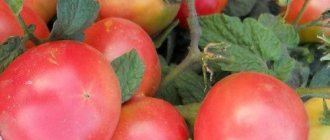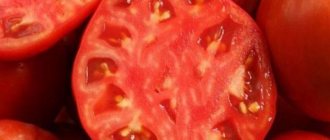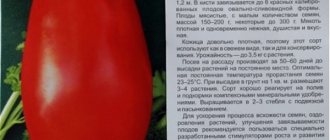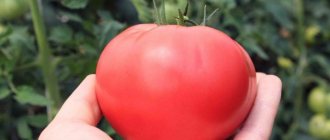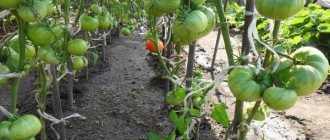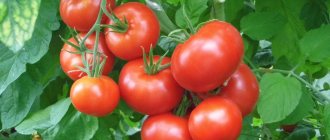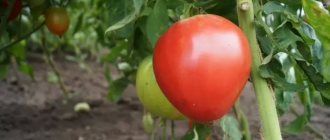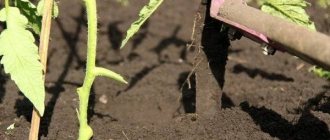One Hundred Poods is an unusual variety of tomatoes. The name of the cultivar demonstrates its most striking feature. The plant produces large and weighty fruits, shaped like a huge heavy drop. But to grow amazing tomatoes with your own hands, you will have to try.
| Height | Landing location | Ripening time | Fruit color | Fruit size | Origin | Fruit shape |
| Tall | Greenhouse, Open ground | Mid-season | Reds | Large | Hybrid | Pear-shaped |
Description and characteristics of the variety
The tomato variety One Hundred Poods was included in the State Register of the Russian Federation in 2013. In just a few years, it has become very popular among Russian gardeners, who leave only positive reviews .
- Mid-early, with a long fruiting period, produces ripe tomatoes 110 days after sowing the seeds.
- Indeterminate type of bush, without limited growth. In a greenhouse, plants grow up to 2-2.5 m in height. In open ground they usually do not exceed 1.5 meters. Requires gartering of stems and brushes as they grow.
- Long-term fruiting, however, may stop under unfavorable weather conditions.
- Suitable for cultivation in greenhouses and greenhouses in the central and northern regions of Russia. In the southern regions it can be grown in the garden without shelter.
Advice! One Hundred Poods bears fruit best in greenhouse conditions.
- It is not standard, so it is necessary to remove excess stepsons, leaving a stump of 5-7 mm so as not to damage the main stem.
- It is recommended to grow in 1-2 stems.
- 28-30 days before the end of the season, you need to pinch the top so that all the formed tomatoes have time to ripen.
- 3-5 ovaries appear on each flower cluster.
- There are few leaves, they are small and dark green in color. It is recommended to partially remove the leaves for proper distribution of nutrients and for preventive purposes.
- Productivity is good, 1 bush produces up to 6 kg of ripe tomatoes (8-9 kg sq. m).
- Resistant to nightshade diseases, but requires preventive measures. The soil must be disinfected before planting. The greenhouse must be regularly ventilated, and the soil under the bushes must be loosened every week. Weeds and dry leaves must be removed, and the bushes must be sprayed with phytosporin to prevent the appearance of fungal diseases.
- Undemanding in care, resistant to temperature changes.
Tomato variety Hundred Poods, video
If you grew Hundred Poods tomatoes, please write whether you liked them or not. What was the yield and taste of fruits like under your climatic conditions? How do you rate the disease resistance of this tomato? If possible, attach a photo of the entire bush or individual fruits you grew to your comment. Thank you!
Your reviews of One Hundred Poods tomatoes and additions to the description will help many gardeners evaluate this variety more objectively and decide whether it is worth planting or not.
This is a natural variety of tomato. Therefore, we recommend taking seeds from a ripe fruit and using them for planting in subsequent seasons.
Features of cultivation
One hundred poods can be grown using the seedless or seedling method. Before sowing, seeds should be treated with Zircon growth stimulator. You can make the soil yourself by combining equal parts of garden soil, old humus or peat. You can also add superphosphate or wood ash to the soil mixture to increase the nutritional value of the soil.
The soil is poured into containers and the seeds are buried into it 1-1.5 cm with an interval of 2 cm from each other. The containers are covered with film and left in a room with a temperature of 25 degrees or higher. The film is removed when small sprouts appear on the surface of the earth. The boxes are transferred to a room with a lower temperature (17-18 degrees).
After the formation of 2 strong leaves, the seedlings are planted in separate cups and liquid complex mineral fertilizers are applied.
After 60 days, the seedlings can be transplanted into the greenhouse.
When growing the Hundred Poods tomato variety using the seedless method, the seeds are sown immediately in the holes, where humus is first added. Water the plantings with warm water. During 1 season it is necessary to feed the bushes 3-4 times:
- Before flowering, nitrogen fertilizers (azophoska) are applied;
- after the formation of the ovaries, fertilize with magnesium sulfate or superphosphate.
More information about growing tomatoes is described in the article: Technology of growing tomatoes. Secrets of planting and care
You might be interested in: How to properly plant tomatoes in a greenhouse: bush formation diagram, care features, photos and videos
Useful information: How to properly tie tomatoes in open ground: the best methods, step-by-step photo and video instructions
Advantages and disadvantages
Pros:
- unusual shape;
- high productivity;
- tolerance to lack of light;
- genetic resistance to major diseases.
Minuses:
- it is necessary to form a bush;
- requires strong support;
- heavy fruits require a separate garter;
- does not ripen early;
- You cannot collect your own seeds.
There are many salad varieties, more than a thousand, and up to half of them are characterized by excellent fruit taste. Therefore, we need to understand why the Hundred Poods variety interested gardening enthusiasts with a rather ordinary taste. Probably, first of all, the exotic shape of tomatoes. Among the advantages of the variety are:
- easy care for a determinate variety;
- quite good yield;
- large fruit;
- ability to ripen in apartment conditions;
- relative shade tolerance;
- normal tolerance of sudden temperature fluctuations;
- increased content of nutrients in fruits.
Among the disadvantages is the need for shaping and tying (although what a disadvantage this is, this applies to more than half of the varieties), as well as imperfect taste. Let’s leave the unusual shape of the fruit out of the picture: after all, it’s not always easy to even wash corrugated vegetables, and aesthetic problems can arise when slicing. Rather, this variety is for those who like experiments, or even exotic things.
Among the many salad varieties, One Hundred Poods, of course, cannot be considered among the best. You can compare it with similar ones in shape. There are already a little less than a hundred tomatoes with pear-shaped fruits, and among them there are very few that are “well-known.” Although, of course, there are some quite good ones. For example, the red Grushka tomato has almost the same yield as Hundred Poods, although its fruits are several times smaller.
But they taste great and are suitable for any purpose. The new Miracle Wonderful variety, registered in 2021, is also characterized by the excellent taste of tomatoes with a weight of about 200 g. In shape, it even resembles the variety in question, but the ribs are less pronounced, and the color of the fruit is yellow.
The late-ripening variety Cheerful Neighbor has strong ribbing. Its fruits are even larger than those of Hundred Poods, but their shape is flat-round and the taste is good. The Novosibirsk variety Mushroom Basket has approximately the same characteristics. Considering the properties of heavily ribbed tomatoes, it should be noted that most of them do not shine with taste;
Among the positive features of the variety are:
- Great taste.
- High yield.
- Easy to care for.
- Resistance to diseases and temperature changes.
- Long-term fruiting.
Among the disadvantages are the following:
- The need to form and tie up the bush.
From the described characteristics it is clear that “One Hundred Poods” is a real find for farmers, as it meets all the necessary parameters of marketability. It is worth highlighting the following advantages of the variety:
- high tasting qualities;
- in terms of the amount of useful elements, the variety can be classified as a dietary product;
- high yields even if the rules of agricultural technology are not followed;
- good transportability, marketability, possibility of ripening;
- resistance to major tomato diseases;
- tolerates drought and sudden temperature changes.
But there are also disadvantages determined by indeterminacy. First of all, this is the need to form a bush of 1-2 stems with constant pinching. Due to the growth of the plant, the stems require regular staking. Support is also necessary for the hands themselves, which carry an impressive amount of weight.
The main advantages of the variety:
- wonderful dessert taste, very healthy;
- productivity is high;
- tomatoes are stored for a long time and have an excellent presentation;
- transportable;
- easy to care for;
- tolerates sudden temperature changes and drought;
- has immunity to major diseases.
The disadvantages include the need to form a bush. Tall plants need strong support; not only stems need to be tied up, but also heavy branches with fruits.
How to care for tomato beds
Caring for greenhouse and ground cucumbers differs insignificantly. In a garden, the temperature and humidity of the air are controlled by the weather, but in a greenhouse this is done by the gardener. If it is not equipped with automatic ventilation and irrigation systems, you have to open the windows and water it yourself.
Watering
In hot weather, actively vegetating bushes are watered at least 2 times a week. They spend a lot of water; it should moisten the soil to a depth of 40–45 cm. With surface watering, a superficial root system is formed, which does not provide adequate nutrition to the Sto Poodov tomato bushes.
Comment! When tomatoes ripen en masse on the bushes, watering is reduced to once a week.
Top dressing
Feed the rooted seedlings for the first time. It takes her 2 weeks to adapt after the transplant. During this period, bushes consume a lot of nitrogen because they are actively growing green mass. Suitable fertilizers during this period:
- mullein infusion;
- herbal infusion;
- ammonium nitrate or urea - 1 tbsp. l per bucket
During flowering and fruiting, Hundred Poods need to be fed twice with phosphorus-potassium fertilizers. If the weather worsens, spray with a solution of boric acid with iodine or whey with iodine.
Stepson and garter
Remove stepchildren at least once a week. Keep the bush with 1, maximum 2 trunks. For tying, use soft knitting. They can be cut from old, disused items. Do pinching and tying lashes all season long.
Control of diseases and harmful insects
In a greenhouse that is properly prepared for the new season, equipped with comfortable windows, Sto Poodov tomatoes do not get sick or are affected by insects. When resorting to standard preventive measures, gardeners rarely use chemicals. When insects appear, folk remedies are used. Prepare infusions:
- ash;
- onion peel;
- celandine.
Diseases and pests
The cultivated variety is resistant to diseases, but preventive measures must be taken. Before planting seedlings, spill the soil with a solution of copper sulfate. Every year, completely change the top layer of soil in the greenhouse. Ventilate the greenhouse every day. Spray the plantings with phytosporin to prevent fungal diseases.
If the bushes are attacked by parasites, use insecticides or wash the bushes with warm water and soap, ammonia, or celandine infusion.
Pour 200 g of dried celandine into 5 liters of hot water, leave for 2 days, then spray the bushes. You can spray the bushes with the biological product Bitoxibacillin, pouring 35 ml into 5 liters of water.
Sowing seeds
Seeds are sown for seedlings in the third decade of March. Before sowing, place the seeds in a gauze bag and dip them in a pink solution of potassium permanganate for a quarter of an hour. Next, add 2 drops of Zircon to 100 ml of water and soak the seeds for 6 hours.
See also
Description of the Maximka tomato variety, cultivation and careRead
Make the soil by mixing garden soil with humus, peat, add a little superphosphate and ash. Heat the soil for 20 minutes in the oven at 200 degrees.
When planting, deepen the seeds 1 cm, water the plantings with a spray bottle, cover with film, and place in a warm room.
When shoots appear, remove the film and place the sprouts on the windowsill. Water with a spray bottle or watering can. When 2 true leaves grow, pick up the seedlings. Then fertilize with a solution of complex mineral fertilizer.
When to plant seedlings in a greenhouse? When the seedlings are 2 months old, transplant them into a greenhouse. The seedlings are planted in the place where cucumbers, legumes, cabbage, onions, and carrots previously grew.
When planting seedlings, first drive in the stakes, then place 3 to 4 bushes per 1 m². Water the seedlings. Immediately tie the bushes onto a trellis.


